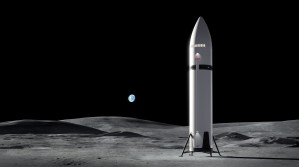Lyndsey McMillon-Brown has taken her love of art, books, and the environment and turned it into a career at NASA’s Glenn Research Center in Cleveland.
“I really love sports, art, and reading. I also love plants,” said McMillon-Brown. “I find that the things I enjoy contribute to my creativity and how I problem solve in the lab. Sometimes I’ll think reading a book or going on a hike is wasting time, but then I realize a design I created was influenced by art or nature.”
McMillon-Brown works with solar cells, which convert energy from light into electricity. As a research electrical engineer, she designs and develops solar cells to be more affordable, efficient, and lightweight for use on Earth and in space.
“Solar cells are important because they’re a green way for us to continue our way of life without having to burn as many fossil fuels or create harmful emissions,” said McMillon-Brown. “When you look at space travel and exploration, they become much more important because there are no outlets on Mars! Fortunately, the sun shines on all the places we visit, so we’re able to harvest the power of the sun and sustain our astronauts, their health and habitat, and our exploration.”
Nearly all missions need some solar power, including Artemis.
However, developing solar cells for space can be incredibly challenging. A spacecraft is constantly exposed to harsh environments, including extremely hot and cold temperatures or high-energy particles that can cause damage. Also, traditional solar cells made from crystalline materials are heavy and expensive to produce.
McMillon-Brown is developing a new type of solar cell made from Perovskite, a lightweight, flexible, and cost-effective material. McMillon-Brown and her team are enhancing durability and testing design variations on the International Space Station.
“We put them in low-Earth orbit for six to 10 months,” said McMillon-Brown. “Once they’re returned to us we examine their performance and make improvements. Then we put them on the next mission.”
These newly designed solar cells could be ideal for future Artemis missions because they are easy to produce.
“They’re thin and flexible, so you can actually print them out not too dissimilar to how you print newspapers,” said McMillon-Brown. “What we envision is taking the raw materials of the solar cells to the Moon and manufacturing them when we get there. This will allow us to make very large arrays that will give us a lot more power.”
McMillon-Brown is a true trailblazer, inventing new ways to provide reliable power on the Moon, Mars, and beyond. Even as a child, she knew she wanted to be involved in space exploration.
“I feel like its cliché, but as a kid I was quite fascinated with NASA,” said McMillon-Brown. “I went to space camp when I was in elementary school and loved it, so I was definitely looking for an opportunity to work here.”
McMillon-Brown studied mechanical and manufacturing engineering at Miami University in Ohio and received her master’s and doctorate in chemical engineering from Yale University. While she was in school, she joined the agency’s Pathways program, where she found her love for photovoltaics, solar cells, and NASA.
“One of the reasons I love working at NASA is because I think we are enabling exploration and the learning of the environment around us and we’re uncovering knowledge and exploring the next frontier,” said McMillon-Brown. “But I also love that we are compassionate about the environment and about people. It’s like a guilt-free job for my soul, I feel like I’m helping the world and I love that.”
McMillon-Brown encourages anyone interested in Science, Technology, Engineering, and Math (STEM) to follow their dream, even though the journey can be challenging.
“I’m working in a field where I’m doing things no one has done before,” said McMillon-Brown. “There’s no answer in the back of the book; we’re laying the path as we walk down it, and that’s challenging. But it’s also very fun and really rewarding.”
“You have to buckle down, focus on the task at hand, and don’t get discouraged,” she said. “Take your time and enjoy the journey because it really is a journey of lifelong learning.”
NASA is in a Golden Era of aeronautics and space exploration. In partnership with commercial and private businesses, NASA is currently making history with significant missions such as Artemis, X-57 Maxwell, and X-59 Quesst. The NASA’s Modern History Makers series highlights members of NASA Glenn’s workforce who make these remarkable missions possible.





























